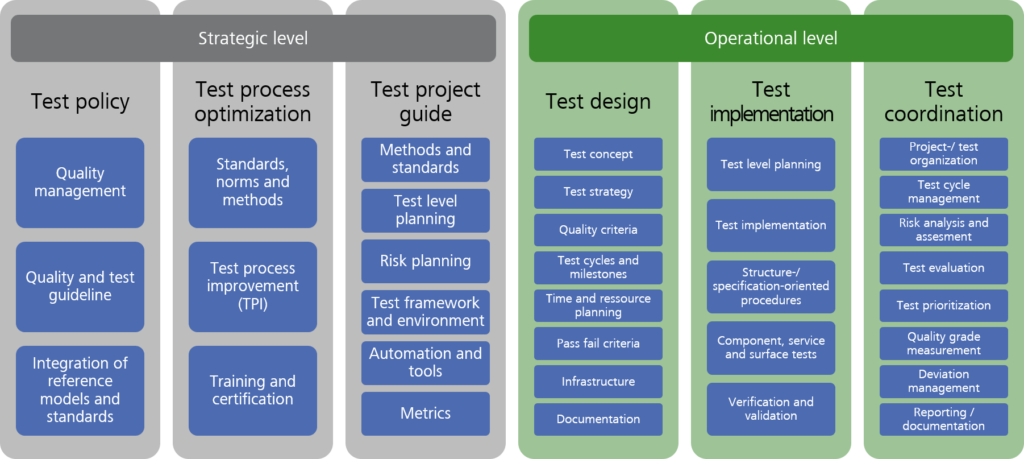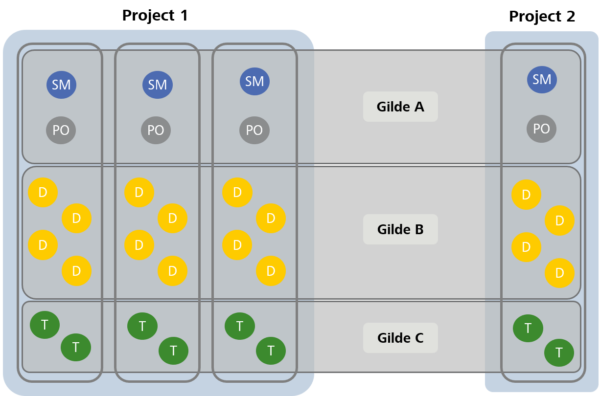In the first part, we successfully completed the agile transition of the test manager’s operative responsibilities, and we proved that small scrum teams no longer require a test manager. But will this work for the test manager’s strategic responsibilities, too? And who assumes the test manager’s strategic responsibilities?
Who assumes the test manager’s strategic responsibilities in agile companies?
A test manager’s strategic area of responsibility includes quality management (QM), which, according to ISO 8402, comprises “all activities of the overall management function that determine the quality policy, objectives and responsibilities and implement them by means such as quality planning, quality control, quality assurance and quality improvement within the quality system”.

Irrespective of whether a company uses traditional or agile methods in development, the company’s management is responsible for the quality management. The scrum team cannot, should not and must not assume this responsibility. At first glance, nothing in the organization and the division of responsibilities changes. At second glance, however, a problem arises for agile companies. In the traditional world, the test manager used to act as the interface between the operative and the strategic level. They transmitted information between the management and the operative level, passed strategic specifications and methods on to the test teams, or forwarded developments and improvements to the management.
But how does information get transmitted from the strategic to the operative level and vice versa in an agile environment? The answer: The agile transition does not stop with the allocation of the test manager’s operative responsibilities to the scrum team. The solution for the agile transition of the “interface” between the two levels is similar to the agile transition of the test manager’s operative responsibilities. New concepts and tools are available for the current corporate communication tasks.
One of the new concepts is the so-called guild. Guilds (called competence teams in our company) are a tool that puts and keeps knowledge and information management on track. They are organized in a matrix structure apart from the normal company structure. The objective of the guilds is to pool the company’s know-how carriers, offer the staff a platform to exchange knowledge or carry out training programs, or agree general project decisions such as the development of test environments or rules for code quality. Depending on the company’s goals, the structure and composition of the guilds can differ: For example, guilds can be divided according to competence areas such as Java development, .NET development, test or process analysis. Or entire scrum teams can be aggregated in guilds, working together on a specific subject in the project, such as QA, database connection, GUI, or interfaces (see Figure 1).

The guilds work according to the following pattern: The primary role that each employee assumes in their daily work (e.g. developer, tester [QAlas], product owner and scrum master) is determined. With this role, they are allocated to a corresponding guild. Within the guild, the members exchange information relating to their areas of responsibility, carry out in-house training seminars, collect the available knowledge in portals, or discuss best practices in individual projects. A guild master is responsible for the moderation and coordination within the guild. In accordance with the motto “primus inter pares”, they do not have more rights than their colleagues in the guild, and they are elected from among the guild members. The guild master is the principal contact for the members of their own guild, the other guild masters and the management. This is necessary because the guilds engage in active interdisciplinary exchange, and they are also supposed to forward feedback from the operative level—such as new developments or technologies—to sales, or suggestions regarding training seminars to HR.
In the last part, we will look at what happens when several scrum teams work together on the same project and the effort required to coordinate them increases for the field of QA as well.